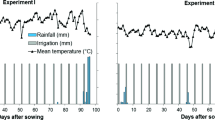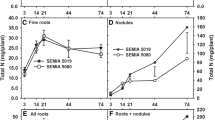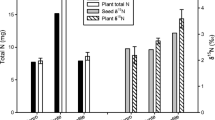Abstract
Improvement of dinitrogen fixation in beans (Phaseolus vulgaris L.) will depend on the selection of superior plant genotypes and the presence of efficient rhizobial strains. This study was conducted to evaluate diverse bean lines for N2 fixation potential using the15N-depleted dilution technique under field conditions in Wisconsin, USA. Plants of 21 bean lines and three non-nodulating isolines of soybean received appliin Wisconsin, USA. Plants of 21 bean lines and three non-nodulating isolines of soybean received applications of15N-depleted ammonium sulphate. Shoots harvested at the V6, R3 and R7 stages and dry seeds were analyzed for total N using the Kjeldahl procedure, and the ratio of15N to14N was determind on a MAT 250 mass spectrometer. Nodule occupancy of the applied strain ofR. leguminosarum biovarphaseoli, CIAT 899, was determined in five of the bean lines. Total shoot N content showed a pattern of accumulation similar to shoot dry weight and fixed N2 in the shoot. Based on shoot total N, N2 fixed in the shoot and shoot dry weight Riz 30 and Preto Cariri were identified as being as good fixers as Puebla 152 and Cargamanto appear to begin N2 fixation early. Furthermore, some bean lines that fixed considerable N2 did not translocate a large amount of N to the grains. Preto Cariri accumulated 21.2 kg N ha−1 in the seeds compared to Puebla 152 which accumulated 43.8 kg N ha−1 of the fixed N2 into the grains. At the early sampling, Puebla 152 and 22–27 had a considerable higher percentage of their crown nodules formed by the inoculant strain CIAT 899, than did Rio Tibagi which has been considered a poor N2 fixer.
Similar content being viewed by others
References
Ames P and Bergman K 1981 Competitive advantage provided by bacterial motility in the formation of nodules byRhizobium meliloti. J. Bacteriol. 148, 728–729.
Attewell J and Bliss F A 1985 Host Plant characteristics of common bean line selected using indirected measures of N2 fixation.In Nitrogen Fixation Progress. Eds. H J Evans, P J Bottomley and W E Newton. pp. 3–9. Martinus Nijhoff Publishers, Dordrecht, The Netherlands.
Barnes D K, Heichel G H, Vance C P and Ellis W R 1984 A multiple trait breeding program for improving the symbiosis for N2 fixation betweenMedicago sativa L. andRhizobium meliloti.In Breeding Legumes for Enhanced Symbiotic Nitrogen Fixation. Eds. G Hardarson and T A Lie, pp. 31–41. Martinus Nijhoff/Dr. W. Junk Publishers, Dordrecht, The Netherlands.
Bergersen F J 1980 Analysis of nitrogen by direct means.In Methods for Evaluation Biological Nitrogen Fixation. Ed. J F Bergensen. pp. 65–110. J. Wiley and Sons Chichester, UK.
Boddey R M, Chalk P M, Victoria R L and Matsui E 1984 Nitrogen fixation by nodulated soybean under tropical field conditions estimated by15N isotope dilution technique. Soil Biol Biochem 16, 583–588.
Broadbent F E and Carlton A B 1980 Methodology for field trials with nitrogen-15-depleted nitrogen. J. Environm. Qual. 9, 236–267.
Broadbent F E, Nakashima T and Chang G Y 1982 Estimation of nitrogen fixation by isotope dilution in field and greenhouse experiments. Agron J. 74, 625–628.
Burris R H and Wilson P W 1957 Methods for measurement of nitrogen fixation.In Methods in Enzymology, Vol III. Eds. N O Colowick and N O Kaplan. pp. 355–366, Academic Press, NY.
DuBois J D and Burris R H 1986 Comparative study of N uptake and distribution in three lines of common bean (Phaseolus vulgaris L.) at early pod filling stage. Plant and Soil 93, 79–86.
Duque F F, Neves M C P, Franco A A, Victoria R L and Boddey R M 1985 The response of field grownPhaseolus vulgaris to Rhizobium inoculation and the quantification of N2 fixation using15N. Plant and Soil 88, 333–343.
Fried M and Broeshard H 1975 An independent measurement of the amount of nitrogen fixed by a legume crop. Plant and Soil 43, 707–711.
Gepts P, Osborn T C, Rashka K and Bliss F A 1986 Phaseolinprotein variability in wild forms and landraces of common bean (Phaseolus vulgaris): Evidence for multiple centers of domestication. Econ. Bot. 40, 451–468.
Gepts P and Bliss F A 1986 Phaseolin variability among wild and cultivated common beans (Phaseolus vulgaris) from Colombia. Econ. Bot. 40, 469–478.
Graham P H 1981 Some problems of nodulating and symbiotic nitrogen fixation inPhaseolus vulgaris L.: A review. Field Crops. Res. 4, 93–112.
Graham P H and Halliday J 1977 Inoculation and nitrogen fixation in the genusPhaseolus. In Exploiting the Legume-Rhizobium Symbiosis in Tropical Agriculture. Eds. J M Vincent et al., pp. 313–334. Hawaii Misc. Publ.
Graham P H and Temple S R 1984 Selection for improved nitrogen fixation inGlycine max (L.) Merr andPhaseolus vulgaris L.In Breeding Legumes for Enhanced Symbiotic Nitrogen Fixation. Eds. G Hardarson and T A Lie. pp. 43–55. Martinus Nijhoff/Dr. W. Junk Publishers, Dordrecht, The Netherlands.
Madsen E and Alexander M 1982 Transport of Rhizobium and Pseudomonas through soil. Soil. Sci. Am. J. 46, 557–560.
McFerson, J R 1983 Genetic and Breeding Studies of Dinitrogen Fixation in Common Bean (Phaseolus vulgaris L.) Ph.D. Diss. University of Wisconsin, Madison.
Minchin F R, Witty J F, Sheehy J and Muller M 1983 A major error in the acetylene reduction assay decreases in nodular nitrogenase activity under assay conditions. J. Exp. Bot. 30, 641–649.
Patterson F G and La Rue T A 1983 Nitrogen fixation by soybeans: Seasonal and cultivars effects and comparison of estimates. Crop. Sci. 23, 488–711.
Pereira P A A, Araujo R S, Rocha R E and Steinmetz S 1984 Capacidade de genotipos de feijoeiro de fixar N2 atmosferico. Pesq. Agropec. Bras. 19, 811–815.
Pereira P A A, Miranda B, Wolyn D and Bliss F A 1986 Genotypic variability and combining ability for nodule number in common bean. Bean Improv. Rep. 29, 87–88.
Rennie R J 1986 Comparison of methods of enriching a soil with nitrogen-15 to estimated dinitrogen fixation by isotope dilution. Agron. J. 78, 158–163.
Rennie R J and Rennie D A 1983 Techniques for quantifying N2 fixation in association with non-legumes under field and greenhouse conditions. Can. J. Microbiol. 29, 1022–1035.
Ronis D H, Sammons D J, Kenworthy W J and Meisinger J J 1985 Heritability of total and fixed N content of the seed in two soybean populations. Crop Sci. 25, 1–4.
Ross, P J and Martin, A E 1970 A rapid procedure for preparing gas samples for N-15 determinations. Analyst London 95, 817–822.
Shearer G, Kohl D H and Harper J E 1980 Diustribution of15N among plant parts of nodulating anal non-nodulating isolines of soybean. Plant Physiol. 66, 57–60.
St. Clair D A 1986 Segregation, Selection and Population Improvement for15N Dinitrogen ability in Common Bean (Phaseolus vulgaris L.). Ph.D. Diss. University of Wisconsin, Madison.
Talbott H, Kenworthy W J and Legg J O 1982 Field comparison of the nitrogen-15 and different methods of measuring nitrogen fixation. Agron. J. 74, 799–804.
Vincent J M 1970 A Manual for the Practical Study of Root-Nodule Bacteria. IBP Handbook no. 15. Blackwell Scientific Publications, Ltd., Oxford.
Vose P B, Ruschel A P, Victoria R L, Tsai Saito S M and Matsui E 198215Nitrogen as a tool in biological nitrogen fixation research.In Biological Nitrogen Fixation Technology for Tropical Agriculture. Eds. P H Graham and S E Harris. pp. 575–592. CIAT. Colombia.
Weaver R W and Frederick L R 1974 Effects of inoculant size on the competitive nodulation ofGlycine max (L.) Merril. II Field studies. Agron J. 66, 233–236.
Witty J F 1983 Estimating N2 fixation in field using15N labelled fertilizer: some problems and solutions. Soil Biol. Biochem. 15, 631–639.
Yoneyama T N, Yamada H, Kojima H and Yazaki J 1984 Variation of natural15N abundance in leguminous plants and nodule fractions. Plant Cell Physiol. 5, 1561–1565.
Zapata F, Danso S K A, Hardarson G and Fried M 1987 Time course of nitrogen fixation in field-grown soybean using nitrogen-15 methodology. Agron J. 79, 172–176.
Author information
Authors and Affiliations
Rights and permissions
About this article
Cite this article
Pereira, P.A.A., Burris, R.H. & Bliss, F.A. 15N-determined dinitrogen fixation potential of genetically diverse bean lines (Phaseolus vulgaris L.). Plant Soil 120, 171–179 (1989). https://doi.org/10.1007/BF02377066
Received:
Revised:
Issue Date:
DOI: https://doi.org/10.1007/BF02377066




